
Silene nutans is a flowering plant in the genus Silene, most commonly known as Nottingham catchfly.

Silene laciniata is a perennial herb in the family (Caryophyllaceae), commonly known as fringed Indian pink, cardinal catchfly, Mexican campion, Mexican-pink, and campion.
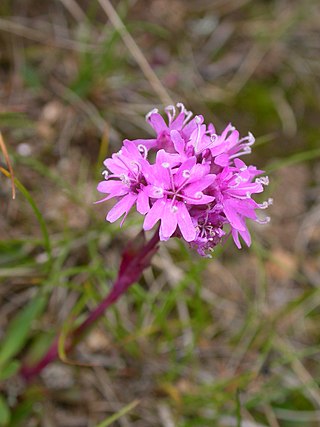
Silene suecica is a species of plant in the family Caryophyllaceae. Its common name is red Alpine catchfly and its natural habitat is the mountains of Norway and Sweden but it is sometimes found near the coasts and it is also found in the Alps and the Pyrenees, Greenland and North America.
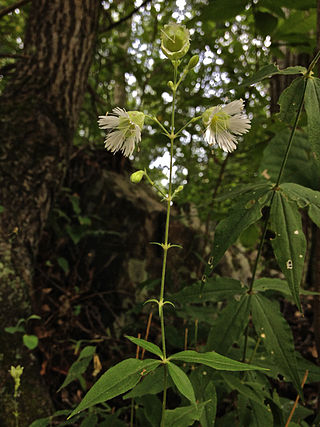
Silene stellata, known by the common names starry campion, widow's frill, and whorled catchfly, is a perennial herbaceous summer forb with white flowers, native to the central and eastern United States. It grows in habitats such as forests, river flats, and tall grass prairies.
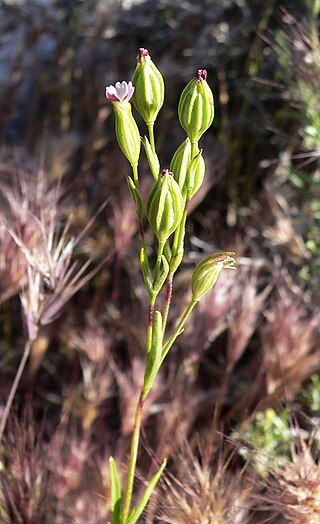
Silene antirrhina is a species of flowering plant in the family Caryophyllaceae known by the common names sleepy silene and sleepy catchfly. It is native to the Americas, where it is widespread throughout North America and parts of South America. It is known in Europe as an introduced species.

Silene campanulata is a species of flowering plant in the family Caryophyllaceae known by the common names Red Mountain catchfly and bell catchfly. It may be a synonym of Silene greenei.
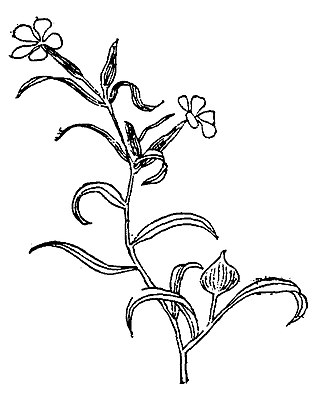
Silene conoidea is a species of flowering plant in the family Caryophyllaceae known by the common names weed silene and large sand catchfly. It is native to Eurasia, and it is known in other parts of the world, such as western North America, as a weed. It is an annual growing up to a meter in height with a hairy, partially glandular stem. The lance-shaped leaves are up to 12 centimeters long near the base of the plant and smaller farther up. The flower is enclosed in an inflated, hairy, glandular calyx of fused sepals which is ridged with many veins. It is open at the top, revealing five bright pink petals.

Silene douglasii is a species of flowering plant in the family Caryophyllaceae known by the common name Douglas's catchfly.

Silene gallica is a species of flowering plant in the family Caryophyllaceae known by several common names, including common catchfly, small-flowered catchfly, and windmill pink. It is native to Eurasia and North Africa, but it can be found throughout much of the temperate world as a common roadside weed.
Silene salmonacea is a rare, newly described species of flowering plant in the family Caryophyllaceae known by the common names Klamath Mountain catchfly and salmon-flowered catchfly. It is known only from Trinity County, California, where it grows in the forests of the southern Klamath Mountains. It is a member of the serpentine soils flora. It is a small perennial herb growing just a few centimeters tall. The spoon-shaped leaves are up to 3.5 centimeters long. The herbage is gray-green and lightly woolly in texture. Each flower has a tubular calyx of fused sepals lined with ten veins. There are five salmon pink petals, each with four lobes at the tip.

Silene noctiflora is a species of flowering plant in the family Caryophyllaceae known by the common names night-flowering catchfly, nightflowering silene and clammy cockle. It is native to Eurasia, but it is known on other continents as an introduced species and sometimes a weed. In North America, it is a common weed of grain crops in the Canadian prairie provinces and in much of the United States. It grows in fields and in other disturbed habitat.
Silene nuda is a species of flowering plant in the family Caryophyllaceae known by the common names western fringed catchfly and sticky catchfly.

Silene scouleri is a species of flowering plant in the family Caryophyllaceae known by the common names simple campion and Scouler's catchfly.

Galearis rotundifolia is a species of flowering plants in the orchid family, Orchidaceae. It is commonly called roundleaf orchis and small round-leaved orchid. It is a succulent perennial herb native to North America, where it occurs throughout Canada, part of the northern United States, and Greenland.

Solidago albopilosa is a rare species of flowering plant in the family Asteraceae known by the common name whitehair goldenrod.

Silene ovata, the Blue Ridge catchfly or ovate-leaved catchfly, is a herbaceous plant in the family Caryophyllaceae. It is a perennial plant growing up to 1.5 m tall, that has numerous white flowers, each finely fringed with a tube. It has large opposite leaves without petioles, which are 5–12 cm (2.0–4.7 in) long and taper to a long point, and 2–5 cm (0.79–1.97 in) wide.

Silene regia is a species of flowering plant in the family Caryophyllaceae known by the common name royal catchfly. It is native to the central United States. A perennial herb, it grows from a fleshy taproot and has several erect stems growing up to 1.6 meters tall. The leaves are lance-shaped to oval and up to 12 centimeters (4.7 in) long, becoming smaller farther up the stem. The inflorescence is an array of many flowers at the top of the stem. The elongate tubular calyx of sepals is up to 2.5 centimeters (0.98 in) long and has 10 longitudinal veins. The lobes of the bright red corolla are 1 to 2 centimeters long.
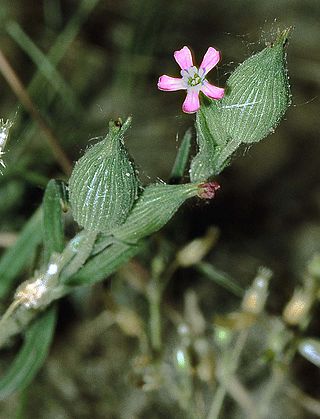
Silene conica is a species of flowering plant in the family Caryophyllaceae known by the common names striped corn catchfly and sand catchfly. It grows in dunes and sandy soils and is widespread in Europe and western Asia. It has an annual life history and produces self-compatible hermaphroditic flowers and occasional male-sterile flowers. Like other members of Silene section Conoimorpha, S. conica is readily recognizable based on its bright pink petals and the prominent, parallel veins on its calyx. In contrast to most flowering plants, S. conica appears to have a very rapid rate of mitochondrial mutation, and has the largest mitochondrial genome ever identified.

Silene uralensis, known by the common name apetelous catchfly or nodding campion, is a perennial plant found in Greenland, northern Canada, Alaska, East Asia, and Siberia.

















